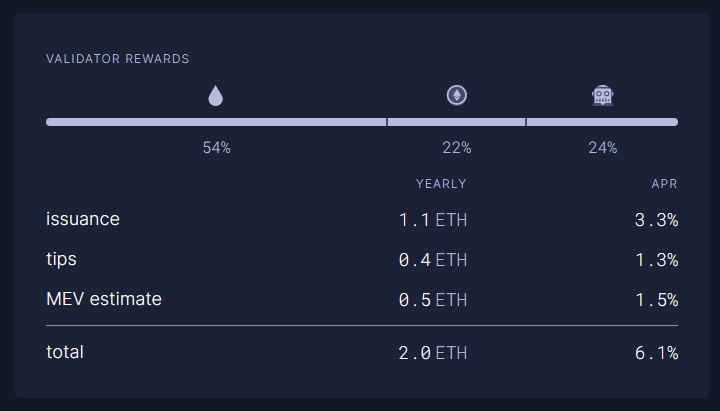💰Guide | MEV-boost for Ethereum Staking
Quickstart guide to setting up MEV-boost for your ETH validator.
❓What is mev-boost?
Enables solo and home stakers access to MEV, Maximal Extractible Value.
Enables validators to earn higher block rewards.
Optional and not required for ETH staking.
Open source middleware run by validators to access a competitive block-building market.
Built by Flashbots as an implementation of proposer-builder separation (PBS) for proof-of-stake (PoS) Ethereum.
home-staker (you) >> mevboost >> relay >> builder >> searcher +/- frontrun/sandwich += efficient markets :)

⚒️ How to MEV?
Prerequisite: You run a full Ethereum node (Execution Layer client [e.g. geth/besu/nethermind/erigon] + Consensus Layer client [e.g. prysm/lighthouse/teku/lodestar/nimbus]) and a validator.
Step 1: Create mevboost service account
The systemd service will run under this account, mevboost
Step 2: Install mevboost
Downloading binaries is often faster and more convenient.
Building from source code can offer better compatibility and is more aligned with the spirit of FOSS (free open source software).
Create the mevboost systemd unit file.
The ExecStart line lists relays: Flashbots, UltraSound, Aestus, bloXroute Max Profit, WenMerge. Remove or add other relays according to your preferences. Add as many or as few relays as you wish.
Paste the following into your mevboost.service file. To exit and save from the nano editor, press Ctrl + X, then Y, thenEnter.
Reload systemctl to pickup the new service file.
Enable mevboost to automatically startup at system reboots and start the service.
Check that the service started successfully.
Sample of systemd logs showing mevboost running nominally.
View Logs with the following command:
Sample of logs showing mevboost running nominally.
Step 3: Update consensus client and validator
Consensus Client Layer Changes (beacon chain)
Add the appropriate flag to the ExecStart line of your consensus client service file.
Select the tab appropriate to your staking setup.
To exit and save from the nano editor, press Ctrl + X, then Y, thenEnter.
Option 1: Systemd service file configuration - Use for V2 Teku staking setup
If your Teku client is configured by --parameters in the systemd service file, add the following changes.
Option 2: TOML Configuration - Use for V1 Teku staking setup
If your Teku client is configured by passing in a TOML file (i.e. teku.yaml), edit teku.yaml with nano.
Add the following lines to the yaml file:
For example, here is the expected result of an updated ExecStart line of a V2 Staking Setup Prysm consensus client service file.
Flag is added on the last line.
When adding a new line, notice that previous lines require a backslash \
Validator Client Changes
If required, add the appropriate flag to the ExecStart line of your validator client service file. To exit and save from the nano editor, press Ctrl + X, then Y, thenEnter.
For Teku running in standalone validator configuration,
For Teku running in combined BN+VC configuration, there is no extra configuration needed.
For Nimbus running in standalone validator configuration,
For Nimbus running in combined BN+VC configuration, there is no extra configuration needed.
For example, here is the expected result of an updated ExecStart line of a V2 Staking Setup Prysm validator client service file.
Flag is added on the last line.
When adding a new line, notice that previous lines require a backslash \
After configuring your consensus client and validator to enable mevboost, reload and restart your services. Finally, verify your logs look error-free and show use of the new MEV configurations.
Lighthouse, Lodestar, Prysm
Teku or Nimbus
Lighthouse, Lodestar, Prysm
Teku or Nimbus
Congrats! Your validator with mev-boost will earn more rewards when proposing a block.
🎯 How to Update MEV-boost
Update to the latest release with the following commands.
Review the latest MEV-boost release notes for new requirements or breaking changes.
🗑️ Uninstalling MEV-boost
Finally, remove the Builder API changes made in step 3 to your consensus client and validator.
❓ FAQ
⏭️ Next Steps
💰 MEV Smoothing: Earn rewards on a consistent basis! Potentially share lottery blocks. Average out your MEV rewards.
Smoothly - https://docs.smoothly.money/how-to-guide
Dappnode's Smooth - https://smooth.dappnode.io/how-to
🆕 Stay Updated: Subscribe to flashbot's mev-boost repository to be notified of new releases. Hit the Notifications button.
📞 Stay in contact: Follow MEV-Boost Twitter contributors
🚀 Future ideas: Learn about the future of MEV democratized by PBS.
🎊 Support us on Gitcoin Grants: We build this guide exclusively by community support!🙏
📚 References
👍 Credits
Inspired by Remyroy's Guide on how to Prepare for The Merge
